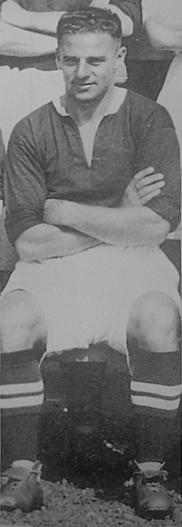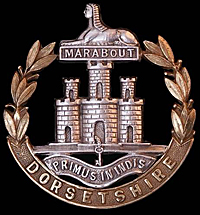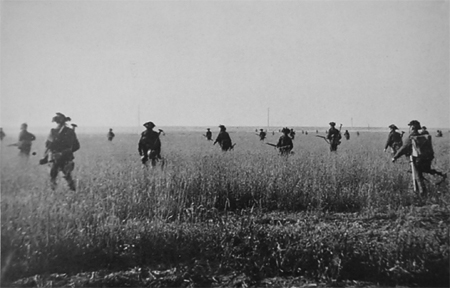|
|||||||||
Alan FowlerThe true and tragic story of Swindon Town's Normandy hero revealed
Footballers are often said to perform ‘heroics’ on the pitch these days, but very few get to be real-life heroes.
Swindon Town striker Alan Fowler literally became a hero when he was killed in action in Normandy in 1944, but now new research has revealed that Fowler’s tragic story comes with a chilling twist.
In peacetime, Alan 'Foxie' Fowler was an all-round sportsman who, despite being only five-and-a-half feet tall, turned out to be a naturally gifted striker. He made an instant impression after signing from his hometown team, Leeds United, in May 1934, scoring on his debut in a 3-1 win over Queens Park Rangers at the County Ground. He went on to be top scorer in three seasons, and ranks twelfth in the all-time list of Swindon goalscorers, netting 102 goals in 224 appearances.
It earned him a place in club historian Dick Mattick’s 2002 book, Swindon Town Football Club: 100 Greats. “At just 5ft 6in,” explained Mattick, “Alan was small for a striker, but he made up for his lack of inches with speed of thought and good ball control. He was no slouch in the air either, as many of his goals came from headers, where his sense of timing enabled him to beat much bigger men.” (Sounds like a description of Town's 2009 star, Simon Cox).
War declared
Fowler would have gone on to be even higher in Town's goalscoring ranks had war not interrupted his career in September 1939, and it was perhaps fitting that he would score the club’s last two goals before hostilities put an end to regular professional football at the County Ground (which was subsequently commandeered as a prisoner-of-war camp). He got both goals in the 2-2 home draw against Aldershot – the third game of the season, and the last until professional football returned, after the war. Fowler briefly returned to Leeds to play wartime football, but with a wife in Swindon and with his parents also now living locally (at 7 Leicester Street), he returned to the area to enlist, and found himself in the Dorsetshire Regiment (often affectionately called ‘The Dorsets’).
Footballers were sometimes cruelly labelled ‘D-Day dodgers’ during the war, perhaps because their sporting prowess made them natural trainers, rather than frontline troops.
Indeed, Fowler was a sergeant PT instructor, and neither was he in the first wave of soldiers ashore in Normandy on D-Day, June 6, 1944. But he would soon see some of the fiercest ever fighting - and experience it first hand. The Dorsets were part of the 43rd (Wessex) Division, which also included two battalions from the Wiltshire Regiment, and others from the south-west. He had been born a Yorkshireman, but he would die a West Countryman. Fowler had already earned praise, long before embarking for France, with the Evening Advertiser later recalling how, in 1941, he “distinguished himself… by saving three men’s lives as well as his own, whilst priming grenades”. No further details of that incident are recorded, but it’s no exaggeration to say that what happened to his regiment on July 10, 1944 has assumed a kind of legendary status in the annals of British Army action, and Fowler's battalion, the 4 Dorsets, were in the thick of it.
To Normandy
The Wessex Division had arrived in France on June 24, and a little over two weeks later were destined to play a key role in one of the pivotal actions of the whole campaign – Operation Jupiter, which was the breakout after the British finally liberated the strategic city of Caen. The plan had been to liberate Caen on D-Day itself, but this wasn’t achieved until the day Alan Fowler died: July 10, 1944.
His battalion had already left Caen behind, and were in the front line, south-west of the city, when, at first light on that sultry morning, their orders were to liberate the towns of Eterville and Martot. This was part of a wider effort to capture the strategic Hill 112 - an operation whose historical importance cannot be overstated.
It was later reported that the Germans, recognising the supreme significance of this one day above all others, remarked: “He who controls Hill 112 controls Normandy.” No wonder the fighting has been described as “of shattering intensity, even by the standard of Normandy”. Eyewitness Sadly, Alan Fowler would not live to see the victory, becoming possibly the first casualty on that fateful day, and probably the most tragic. The details are revealed in Patrick Delaforce’s Book, The Fighting Wessex Wyverns, although it has only now emerged that the Sgt Fowler mentioned in an eyewitness account of the action is the same Alan Fowler who had played inside-right and centre forward for Swindon Town. Not untypically of Normandy battles, the assault began with a massive bombardment of enemy positions, the barrage including intensive artillery and heavily-armed fighter planes, capable of bombing. The story is taken up by Major GL ‘Joe’ Symonds, who commanded the 4 Dorset’s B Company (as quoted in Patrick Delaforce’s book): “We were very close to the barrage, still in excellent formation. About four fighters [Typhoons] came over, presumably a little late, dropped two bombs in the middle of my company. A number of casualties including Sgt Fowler were killed.” There can be no doubt that Fowler therefore died as a result of action from the Allies’ own air support (RAF Typhoons), and was a victim of so-called ‘friendly fire’. Only Fowler’s age in is dispute. Football statisticians claim he was 33, but the inscription on his grave says he was 37. The Evening Advertiser report of his death, meanwhile, put his age at 32.
Controversy
That report is curious – firstly because it did not appear until August 21, nearly seven weeks after the incident, even though other deaths were usually reported within a week. It also claims Fowler “died of wounds”, when clearly he must have been killed instantly or very soon after the Typhoons struck. It is also at odds with the certificate relating to his death, which is kept by the Commonwealth War Graves Commission. This specifically records that Fowler was “killed in action”, whereas those who died of wounds rather than on the battlefield were usually recorded as such. The issue of 'friendly fire' deaths has always been controversial, and there could be some suggestion that the true details of Alan Fowler's death were being concealed. What is certain is that it adds even more tragedy to an already heartbreaking personal story - yet there was another sad postscript to come. His father Joseph, who was assistant groundsman at the County Ground, is said to have never recovered from the grief of losing his son, and died in 1947. The true story of Alan Fowler's death surely only adds to what already was a tragedy, but it does not diminish the honour of one footballer who really can be described as a hero.
Jim Olney and Bill Imrie Two other Swindon Town players died during the Second World War, and all three are honoured together on a plaque inside the County Ground – at least, they are commemorated up to a point. Alan Fowler’s details on the plaque are correct, and it also correctly honours James (Jim) Olney, who was in the Coldstream Guards, although the plaque says Olney was a sergeant, when he was actually a lance sergeant. A centre half, Olney joined Town from Birmingham, less than a year before war broke out, and played in 13 matches. He was killed on September 14, 1944, aged 30, and is buried at Geel War Cemetery, Belgium. However, the plaque has muddled the details of the Town’s third casualty. The inscription refers to ‘IAC James Imrie, RAF’, when, in fact, it should commemorate Scottish international full-back Bill (or Willlie) Imrie, who played two games for the Town, just before the outbreak of war, and died in 1944. Imrie was not killed in action, but died of cancer at his home in Fife, aged just 36, while still in military service. Ironically, one of his two international caps was for a match against Germany in 1929.
Written by Graham Carter |
|||||||||
|
||||||||
|
D-DAY |
||||||||
|
RAF Blakehill |
||||||||
|
The Yanks are Coming!... |
||||||||
|
Swindon on D-Day |
||||||||
|
Flying Nightingales |
||||||||
|
||||||||
|
||||||||
|
||||||||
|
||||||||
|
||||||||
|
||||||||
|
||||||||
|
||||||||
|
||||||||
|
||||||||
|
||||||||
|
||||||||
|
||||||||
|
||||||||
|
||||||||
























